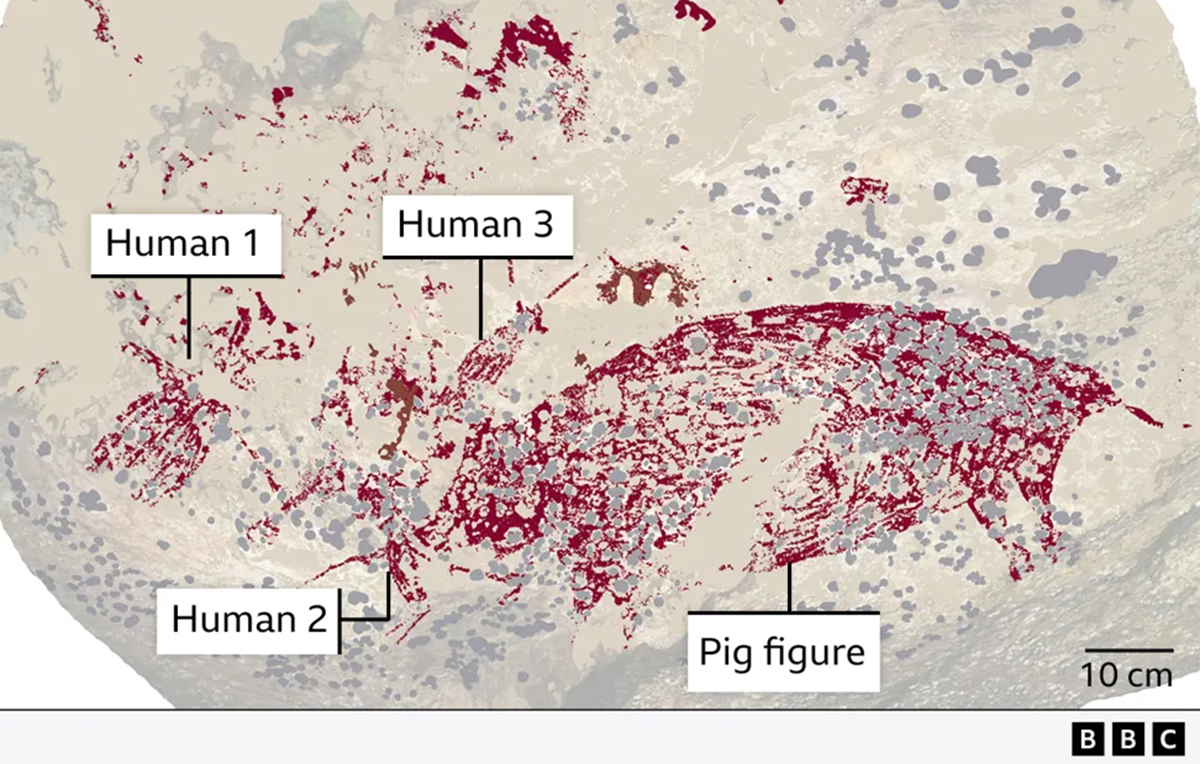


An article on the BBC by Pallab Ghosh, Science Correspondent - World's oldest cave art found showing humans and pig - reports on further research coming out of Indonesia regarding the oldest known rock art.

The oldest example of figurative cave art has been discovered in the Indonesian Island of Sulawesi by Australian and Indonesian scientists. The painting of a wild pig and three human-like figures is at least 51,200 years old, more than 5,000 years older than the previous oldest cave art.
The discovery pushes back the time that modern humans first showed the capacity for creative thought. Prof Maxime Aubert from Griffith University in Australia told BBC News that the discovery would change ideas about human evolution: “The painting tells a complex story. It is the oldest evidence we have for storytelling. It shows that humans at the time had the capacity to think in abstract terms.”
The team of scientists was led by Adhi Agus Oktaviana, an Indonesian rock art specialist from the National Research and Innovation Agency (BRIN) in Jakarta. He says that that narrative storytelling was a crucial part of early human culture in Indonesia from a very early point in time: “Humans have probably been telling stories for much longer than 51,200 years, but as words do not fossilise we can only go by indirect proxies like depictions of scenes in art – and the Sulawesi art is now the oldest such evidence by far that is known to archaeology.”
As the Abstract to the recently published paper in Nature - 'Narrative cave art in Indonesia by 51,200 years ago' - by Adhi Agus Oktaviana et al explains:
'Previous dating research indicated that the Indonesian island of Sulawesi is host to some of the oldest known rock art1,2,3. That work was based on solution uranium-series (U-series) analysis of calcite deposits overlying rock art in the limestone caves of Maros-Pangkep, South Sulawesi1,2,3. Here we use a novel application of this approach—laser-ablation U-series imaging—to re-date some of the earliest cave art in this karst area and to determine the age of stylistically similar motifs at other Maros-Pangkep sites. This method provides enhanced spatial accuracy, resulting in older minimum ages for previously dated art. We show that a hunting scene from Leang Bulu’ Sipong 4, which was originally dated using the previous approach to a minimum of 43,900 thousand years ago (ka)3, has a minimum age of 50.2 ± 2.2 ka, and so is at least 4,040 years older than thought. Using the imaging approach, we also assign a minimum age of 53.5 ± 2.3 ka to a newly described cave art scene at Leang Karampuang. Painted at least 51,200 years ago, this narrative composition, which depicts human-like figures interacting with a pig, is now the earliest known surviving example of representational art, and visual storytelling, in the world3. Our findings show that figurative portrayals of anthropomorphic figures and animals have a deeper origin in the history of modern human (Homo sapiens) image-making than recognized to date, as does their representation in composed scenes.'
Click here for the full article
by Bradshaw Foundation
Monday 03 February 2025
by Bradshaw Foundation
Friday 09 August 2024
by Bradshaw Foundation
Wednesday 24 July 2024
by Bradshaw Foundation
Thursday 04 July 2024
by Bradshaw Foundation
Monday 01 July 2024
by Bradshaw Foundation
Wednesday 20 March 2024
by Bradshaw Foundation
Tuesday 13 February 2024
by Bradshaw Foundation
Tuesday 13 February 2024
by Bradshaw Foundation
Thursday 01 February 2024
by Bradshaw Foundation
Tuesday 28 November 2023
by Bradshaw Foundation
Thursday 23 November 2023
by Bradshaw Foundation
Monday 20 November 2023
by Bradshaw Foundation
Tuesday 31 October 2023
by Bradshaw Foundation
Thursday 26 October 2023
by Bradshaw Foundation
Wednesday 20 September 2023
by Bradshaw Foundation
Monday 17 July 2023
by Bradshaw Foundation
Monday 03 February 2025
by Bradshaw Foundation
Friday 09 August 2024
by Bradshaw Foundation
Wednesday 24 July 2024
by Bradshaw Foundation
Thursday 04 July 2024
by Bradshaw Foundation
Monday 01 July 2024
by Bradshaw Foundation
Wednesday 20 March 2024
by Bradshaw Foundation
Tuesday 13 February 2024
by Bradshaw Foundation
Tuesday 13 February 2024
by Bradshaw Foundation
Thursday 01 February 2024
by Bradshaw Foundation
Tuesday 28 November 2023
by Bradshaw Foundation
Thursday 23 November 2023
by Bradshaw Foundation
Monday 20 November 2023
by Bradshaw Foundation
Tuesday 31 October 2023
by Bradshaw Foundation
Thursday 26 October 2023
by Bradshaw Foundation
Wednesday 20 September 2023
by Bradshaw Foundation
Monday 17 July 2023
Friend of the Foundation











